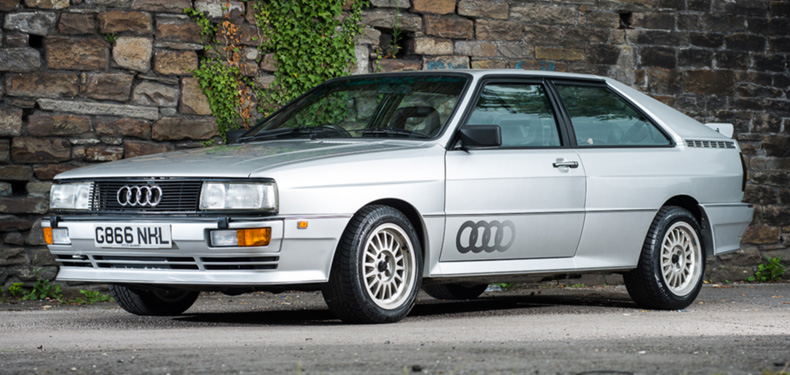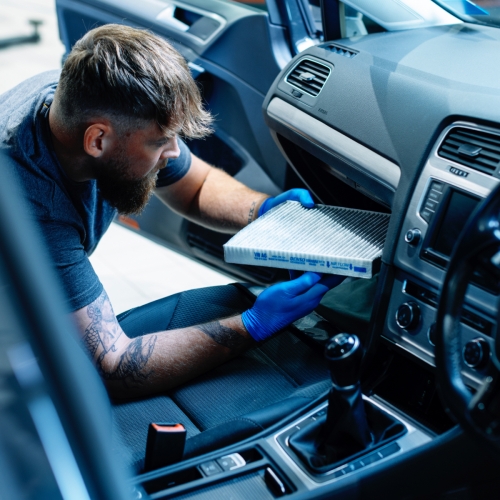Mike Turner, Editor for the Audi Quattro Owners Club, is our latest contributor to choose a Volkswagen Group Icon. From the headline and Mike’s job title you will have guessed his four-wheeled favourite for this edition.
For fans of TV series Life On Mars - or more precisely the follow-up series Ashes to Ashes - the command from legendary TV cop Gene Hunt to ‘Fire Up the Quattro’ was also the cue to fire this Audi classic into popular culture. With its gleaming red paint job and cult cop Hunt behind the wheel, the 1983 model Quattro featured in the show soon drove itself into the affections of a whole new generation of fans. However, long before it was immortalised in the 2008 hit TV series, the Quattro had established a devoted fanbase as a result of its feats on the road and the rally circuit. One such fan is our contributor Mike, who says of his four beloved Quattros: “The greatest pleasure comes from feeling every wheel gripped to the road. Add to this the lovely 5-pot exhaust burble, and you have heaven on four wheels.” As one of the first sports car with permanent all-wheel drive and the capability to go from 0 to 62mph in 7.1 seconds and topping out at 137mph, driving the Quattro is indeed a celestial experience and one always likely to lift the spirits and fire the imagination.

The Quattro was born out of humble beginnings. When Audi chassis engineer, Jörg Bensinger first proposed the idea for a high-performance four-wheel drive car, he based it on the Volkswagen Iltis, a military 4-wheel drive vehicle and the utilitarian Audi 80 saloon. Our contributor Mike picks up the story. “The prototype model suffered from poor manoeuvrability as the Iltis drive had no centre differential. The engineering team were tasked with designing a centre differential to improve this. How this was resolved was a wonderful example of ‘Vorsprung Durch Technik’. “The brilliant idea was to drive another Audi 80 differential placed longitudinally via a hollow propshaft. The revolutionary new transmission was fitted to the Audi Type 85 coupe, built on the same Audi 80 shell and powered by a turbocharged version of Audi’s 5-cylinder engine. The Quattro was born in 1980 and the rest is history.”
What a history it is. From making its debut at the Cologne Motor Show in 1980 to the end of its production run in 1991, an icon was established. A four-wheel drive trailblazer that ushered in a new technical era for road and rally cars. Each one of the 11,452 Quattros produced were individually hand-built at Audi’s Ingolstadt factory and then individually tested, both in the factory and on a test track. When the final Quattro was produced on 17 May 1991, its legend was complete.
While earning its stripes as a production car, it’s the Quattro’s rallying exploits that truly secured its iconic status. When international rally regulations changed in 1979 to allow four-wheel drive cars to compete, it unleashed the Quattro to change the sport forever. In 1981, the Quattro announced itself by enabling Michèle Mouton to become the first female driver to win a world championship rally. Over the next three years, Audi’s A1 and A2 evolutions of the Quattro - developed in response to the equally iconic and infamous Group B rules – dominated the rallying scene. Between 1983 and 1984, legendary drivers Hannu Mikkola, Stig Blomqvist and Walter Röhrl won eight world rallies in the Quattro. By the time the Quattro bowed out of the rally scene in 1986 it had earned its place in motorsport folklore.

As we reach the end of this particular icon journey, it’s best left to Mike to sum up what makes the Quattro so special. “The concept of a rally-performance car that can carry the kids and shopping sounds crazy, but it is true. They are just great cars to drive and own.” The owners’ clubs and enthusiasts in the UK alone are testament to that. A car as equally at home on a forest stage as it is in a supermarket car park, is a rare beast indeed. One that enables its owner to take their motorsport dreams and drive them home is even rarer and an essential part of what makes the Quattro a true icon.




